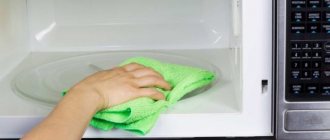Mold is a microscopic fungus that grows on damp or rotting things. The microorganism causes an unpleasant, stale smell in the apartment. To eliminate the enemy, it is necessary to remove the source that provoked the appearance. Simple, affordable products that are stored in the kitchen or in the medicine cabinet will help you get rid of the smell of mold in your closet.
Where to look for the source of mold?
Even if you smell mold in your closet, it doesn't mean it has spread there. The fungus lives in warm and humid places, which means it can be behind a closet wall, in peeling wallpaper, or right in clothes if they are not dried well.
The characteristic colors of mold are gray, green, blue, black. If you find it, immediately take measures to remove it, because the fungus spreads very quickly, affecting any surfaces along the way.
At first you will smell it and only after a while you will see the mold.
How can you tell if it's really the smell of mold if you can't see it yet? Its stench is bitter and damp.
Mold moves into closets with clothes from the following media:
- air ducts;
- rotten walls;
- the back of the furniture;
- rarely used books;
- carpet;
- mattresses;
- ceiling tiles.
Closet cleaning steps
Prepare the water; you can take a little essential oil for aromatization, the smell of which you like. It could be lavender and cloves that repel moths. As in the previous case, empty the closet of things, shelves and drawers. Take a thick bath towel, soak it in cool water and hang it in the closet for 1-2 hours.
- Prepare for cleaning: buy products for cleaning surfaces and washing clothes. If the case is advanced, purchase rubber gloves and a respirator that will protect you when using household chemicals.
- Take things out of the closet and put them aside - they will have to be washed. Open the doors and wipe all surfaces with a damp cloth. Open the windows, doors, balcony, if there is one - the room and furniture should be filled with fresh air.
- Start washing. If there are hopelessly damaged, torn or unnecessary items, throw them away. Wash the rest by hand or in the washing machine. Is the smell still on the items? Soak them in fabric softener for half an hour. Then wash again. This should be enough.
- Dry the clothes thoroughly and iron them. Place pieces of toilet soap on the shelves between the rows of clothes to make your closet smell nice. And now you can place everything in its rightful place.
- Use aromatics: coffee, tea bags, cinnamon, cotton bags of herbs, or anything else you like. They perfectly neutralize foreign odors and prevent the appearance of others.
Cabinet treatment to remove fungus
While the items are drying and washing, sanitize the closet. Furniture is moved away from the walls and, if sources of infection are already visible, they are removed with home remedies - baking soda, vinegar, alcohol (ammonia), citric acid, bleach and chemicals.
As additional measures after treatment, an aromatic sachet is used, which is placed directly in the closet and between layers of clothing after treatment.
How to clean cabinets with baking soda?
All products have their benefits, but the safest of them all is baking soda. It is even suitable for processing cabinets with children's linen:
- Dissolve soda in water. Use 3 tablespoons per liter of water.
- Dampen a sponge or rag in this solution.
- Wipe down the cabinet walls and shelves. Pay attention to the back wall of the cabinet.
- After treating with the solution, wash the cabinet with clean water.
- Keep the cabinet open for 4 days until it is completely dry.
How to clean cabinets with bleach?
Bleach can also deal with odors and fungal growths. But here you need to act differently:
- After emptying the closet of clothes, open the doors and place the dehumidifier inside. If not available, use a fan. If possible, move the cabinet outside into the open air in clear weather.
- Mix equal parts bleach and water and dampen all surfaces of the cabinet. It is very important not to add additional detergents to the composition, this can cause an unpredictable reaction and harm your health.
- After treatment, the inner walls of the cabinet are washed with ordinary cold water.
- Keep the cabinet open for at least three days, further drying it with a fan or dehumidifier.
Make sure there is no trace of odors left in the closet. Each corner of the furniture should be dried and only after that put the clothes back.
Other ways to remove mold smell
The following tools will also be useful:
- Vinegar
.
To apply to surfaces, dilute equal parts of water and vinegar, wipe the surfaces and leave to dry. Hydrogen peroxide
works on the same principle. - Bleaching .
A good product, but not suitable for everyone. Its use can result in white spots on the furniture, so if the cabinet is expensive, try baking soda and vinegar first, and in extreme cases, use bleach. - Chemicals.
Use last because they are not always safe for use in adults or children. If you use it, follow the instructions carefully.
Read our other articles:
- How to get rid of smell in the refrigerator: tips from personal experience.
- How to get rid of unpleasant foot odor:
- How to get rid of an unpleasant smell in an apartment? Methods that will help are described here.
How to make your closet smell more pleasant and gentle
Destroying the fungus helps eliminate the musty smell. At the same time, things can be given a more pleasant aroma. This is quite simple to do; just lay out on the shelves any substances that have a strong aroma. They may be:
- cosmetic soap;
- empty perfume bottles;
- herbal and flower preparations;
- special air fresheners.
Any of these solutions will give things a lasting, pleasant aroma. In addition, an increased concentration of essential oils in the air has a negative effect on the structure of the fungus. It stops actively growing and releasing spores. The choice of a specific product is based solely on the person’s preferences and his desire to diversify the atmosphere of the closet. At the same time, cosmetic soap has a persistent delicate aroma that remains on the fabric for a long time. Perfume bottles impart a delicate, slightly sweetish aroma to things. Herbal and flower infusions have unsurpassed characteristics and not only improve the smell in the closet, but also prevent the appearance of moths. Special fresheners stay on things for a long time, but have a somewhat artificial smell.
A wardrobe is an essential attribute of any apartment. Outerwear, bedding and personal items are just a small part of what can be stored in it. At the same time, the situation when a damp smell forms in the closet is familiar to many. The main reason for this phenomenon is a fungus. It is he who secretes a specific enzyme that people perceive as mustiness. Its neutralization ensures the complete elimination of unpleasant odors, and it can be done using improvised means, which can always be found in any apartment.
What to do if mold is already on clothes?
If the fungus has spread to the walls of the closet, then it is probably already in things. Clothes are taken out to the balcony or outside in the sun on a clear day and aired, first turning them inside out - especially capricious items, so that the fabric does not fade in direct rays.
Simple airing will get rid of the smell and the fungus itself, so after drying, all clothes need to be washed. You don’t need to invent anything - just regular washing with powder. The use of additional odor removal products is encouraged. Linen is dried and always ironed.
But what should you do if, in addition to the smell, stains have formed on your clothes? Throw out old things and try to save new ones, but only if the infection is partial. They work with each individual fabric individually:
- Cotton items
are sprinkled with crushed chalk powder, paper sheets are placed on top and ironed without steam. - Silk and woolen items
are sprinkled with dry clay, then a layer of turpentine is applied and covered with paper. Iron the charged areas with a hot iron. Please note that the processing method is only suitable for dark fabrics; light fabrics are not processed this way. - Light and white items
can be cleaned by soaking them in hydrogen peroxide.
If the spots are small, try mixing lemon juice, salt and onion juice. Apply the mixture to the stains and wait 15 minutes.
If the proposed processing methods do not suit you, use regular table salt:
- Add 2 tbsp to a liter of water. spoons of salt;
- Pour in a teaspoon of ammonia;
- Place the liquid on the fire until it boils;
- When the solution boils, remove from heat and wait for it to cool completely;
- The area of fabric with mold is moistened with the solution and left for an hour. Then carry out normal washing.
Regardless of the processing method, the laundry is dried in direct sunlight, washed and ironed without the use of steam. If there are still pockets of mold in the closet, you will never get rid of the smell. An integrated approach is important.
The smell of new furniture
New cabinets almost always smell like varnish.
The evaporation of formaldehyde that is part of the chipboard can also add its own note to this sharp bouquet. If the furniture is of high quality, the smell will disappear within 2–3 weeks. If this does not happen, the owners will have to either return the purchase to the store, or constantly use odor absorbers. The new cabinet is installed in a well-ventilated area, the doors are left open. Weathering will speed up if you place cups of soda in the corners of the cabinet and tea bags (new or carefully dried used ones) on the shelves. If the smell does not completely disappear, you will need to keep the soda and tea in the cupboard constantly, changing them every 3-4 weeks.
Carry out the treatment only after the closet is completely empty of clothes. Today, there are several simple methods that can at the same time kill harmful spores and save wood from further damage. Let’s look at the 2 most effective ones.
The most common method is to treat wood with soda solution. This method is suitable even for a cabinet with children's underwear, as it is safe. Dissolve 3 tbsp in a liter of water. l. soda, then wash the inside of the cabinet with the resulting solution, including all sides, shelves, walls and doors. Leave the cabinet open for 4 days. You can also use hydrogen peroxide. Treating children's cabinets with peroxide is as safe as using soda.
Another effective method is chlorine bleach. But keep in mind that this method of dealing with the problem is not suitable for everyone, since chlorine causes an allergic reaction in many people. The method is suitable for processing a closet where the clothes of adult family members are stored. Carrying out such treatment is unacceptable for disinfecting children's furniture.
First, you should remove all clothes from the closet and dry the inner surface using a special dryer or fan, and only then proceed directly to disinfection. It is better to take the wardrobe out of the room into the open air so as not to breathe in harmful fumes.
Mix equal parts water and chlorine bleach, put on gloves and use the resulting solution to wipe all the walls and shelves of the cabinet, inside and out. When done, wash the cabinet with clean water. It is advisable for the wardrobe to stand for about 3 days in the fresh air, which will help eliminate the unpleasant smell of chlorine.
When processing wardrobes using this method, you do not need to add additional detergents to the water so as not to harm your health. Using bleach allows you to completely clean the surface, which ordinary soda, which is best used at the initial stage of infection, cannot cope with.
How to treat kitchen cabinets?
Kitchen furniture, including household appliances, are also susceptible to mold odors. The first thing you need to do is wash the surface using a solution of water and laundry soap or bleach. Treat the doors, shelves, and walls with the composition.
As an alternative, you can use a vinegar solution, which is prepared using slightly warm water with the addition of seven tablespoons of vinegar. Put on gloves, treat work surfaces with vinegar solution and open the window wide. It is better not to enter the kitchen for several hours, and then you need to wash the surfaces with clean water.
After such procedures, do one of the most attractive things for you:
- Place saucers with coffee beans on the shelves. You can also use ground, but it must be natural. Soluble “sand” will not capture odors as well.
- Place 5 slices of fresh lemon in saucers and place on each shelf. Use the skins and zest too. Lemon absorbs odors perfectly.
- A small bowl of baking soda will absorb unpleasant odors in 3 days. Place containers in the farthest corners.
Sometimes housewives use aromatic products, for example, essential oils, but in the kitchen you need to be careful with this and use it only for walls and floors. In the same place where the products will be placed, the option with essential oils is not suitable.
Prevention
To prevent harmful and dangerous fungi from annoying kitchen utensils, you need to take the following as a rule:
- wash and dry dishes thoroughly;
- do not leave food residues in cups, plates, salad bowls, or pots;
- regularly wipe cabinets and other storage areas for food and utensils in the kitchen;
- be sure to ventilate the room, avoiding high humidity;
- use a high-quality hood when cooking;
- Do not store cereals or flour for a long time. Constantly check products for the presence of moths and fungi.
By following basic rules, the housewife will never allow mold to appear in the kitchen and on dishes in particular. Well, in the event of force majeure, you know what to do!
How to prevent mold?
If you are afraid of mold, take steps to prevent it, which is much easier than having to get rid of it later.
- Buy silica gel balls from a hardware store. They prevent dampness from forming in unventilated places such as closets.
- Ventilate the inside of the furniture and do this once every 4 weeks. Open your closet wide, open the windows and take your clothes out into the sun.
- Carry out wet cleaning regularly.
- Get rid of old things, especially if they already have a characteristic smell.
- In summer, place furs, blankets and pillows in the sun.
- After washing, all items should be ironed.
- During deep cleaning, check the back of the cabinet. This is the first place where mold can form.
If the smell of mold has moved from the closet to the room, then use the tips in this article.
What can cause an unpleasant odor?
Foreign odor may appear for various reasons. The main one is mold. In conditions of high humidity and stable temperature, mold microorganisms actively multiply, and in a closed chest of drawers, their metabolic products quickly begin to give off a characteristic odor that is difficult to get rid of.
Causes of mold:
- Placing insufficiently dried clothes in the closet;
- Formation of excess humidity inside due to the presence of dampness in the room.
Wood absorbs moisture (and odors) well, creating comfortable conditions for mold. Getting rid of it is the first priority.
Another unpleasant smell found in old chests of drawers is mothballs. Previously, balls containing this substance were used against moths, but their persistent odor can persist for decades.
The ability of wood to absorb causes the presence of odor in almost any antique furniture, unless special measures have been taken to get rid of it. An old musty smell is formed by a complex mixture of aromas that have ever been in a given piece of furniture.
Finally, the presence of smokers or active athletes in the house are two more reasons for the appearance of an unpleasant odor.
Where exactly can it appear?
In short, the main places of appearance are:
- Corners in cabinets (upper or lower).
- The back walls of cabinets from the back (more often) or from the inside (less often) (especially if the furniture is located close to the wall bordering the street).
- The space under the closet, if this is a room on the ground floor, and there is an unheated and/or damp basement below.
- The surface of the wall behind the cabinet, if the wall borders the street.
By the way, in addition to cabinets, fungus can also appear in the chest of drawers and under the mattress (if you store things under it).
Even if there is a persistent musty smell from the closet, you cannot be sure that the mold appeared there. It may be that the fungus has settled on the wall behind the closet, and it is from there that the specific stench is felt.
Plaque can also occur in the closet. Most often it is localized in corners or on wooden surfaces that are not sufficiently protected (not treated with varnish at all, or poorly treated, or the varnish coating has crumbled over time). It often extends to clothes and shoes that are in the closet.
Moreover, mold deposits most often develop on things that have not been used for a long time, that have been lying in one place for months. Also at risk are things that are packed too tightly (folded).
Spores may be localized primarily in damp areas of the cabinet. For example, if there is a source of leakage above the cabinet after rains. Therefore, furniture located in utility rooms, attics, and on the top floors of old houses (or houses with a bad roof) suffers most from fungus.
Mold behind the cabinet
Be sure to inspect the corners of the cabinet surface, as well as the area under it - these are also favorite places for mold microorganisms. Inspect the furniture standing near the closet (or, especially, close to it) - disputes could also spread to it.
Be sure to make sure that the clothes you put in the closet are dry: mold appears much faster and more often on damp things.
Reasons for appearance
Main reasons for development:
- Humidity (dampness) in the room where the cabinet is located.
- Storing wet clothes (especially too tight storage).
- The spread of mold with clothes is possible through the washing machine (if the fungus appears in it, then during the washing process the spores can get on things and then be transferred to the closet).
- The location of the cabinet is close to the wall, which can be wet (for example, when it rains).
- Lack of normal air circulation in the furniture (if it is tightly closed and has no cracks, and rarely opens).
- The habit of storing unwashed items.
- Furniture that is too old and has rotten areas.
- Placement of furniture in the corner of the room.
Why is this dangerous?
You need to start with the most banal thing - infected furniture smells unpleasantly of dampness (something like wet clay).
It doesn’t matter what kind of mold has settled inside - white or black, or other colors - it will still stink. In addition, wooden cabinets will rot and fall apart over time, or simply become deformed (although this requires not noticing the fungus on the furniture for a very, very long time).
Damage is also caused to the clothing inside:
- From contaminated clothing, spores can get into the washing machine, from there onto other things, and through them onto any object in the apartment (on the carpet, on the bed, on any other surfaces).
- Things smell bad. Moreover, this causes not only discomfort: if there are a lot of spores in the tissue, then when they are inhaled, a person will begin to sneeze. In particularly difficult cases (if a person has allergies, or is simply in poor health), an allergic reaction is possible.
The accumulation of mold spores can seriously affect the health of residents. Even healthy people are at risk, since mold, being a fairly strong allergen, can trigger the development of bronchial asthma.
If people with bronchial asthma already live in the apartment, then the course of the disease may worsen, repeated attacks of suffocation, and systemic allergic reactions. This includes possible angioedema and bronchospasm, which can be life-threatening.
“Symptoms” of appearance: how to understand that mold has appeared in the closet?
It is hardly worth thinking seriously about how to find out that mold has appeared in an apartment (or specifically in a closet): in most cases, you will not miss it. You can only miss the initial stage, when the fungus has not yet grown and is not noticeable to the naked eye (but there are already spores).
Mold behind the bedside table
Main signs of appearance:
- persistent nasty smell of dampness in the apartment, mustiness (initially weakly felt, intensifies as the amount of fungus increases);
- the development of local or systemic allergic diseases in people who have not previously suffered from them (sneezing, bronchospasm attacks, lacrimation, nasal congestion that occurs when opening a closet or putting on clothes from it);
- the appearance of a mold stain directly in the cabinet itself, or in the area around it (under or above it, on the wall).










